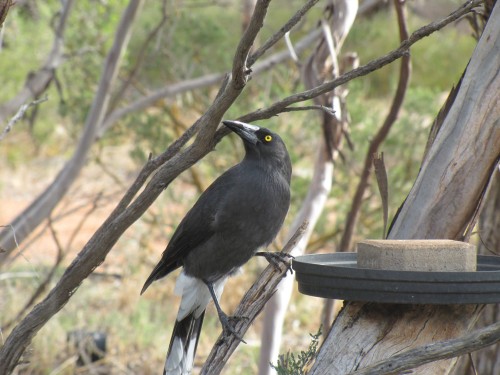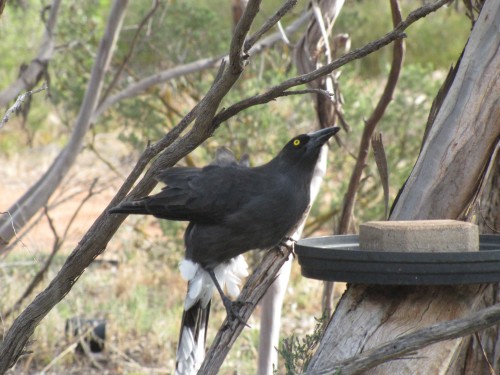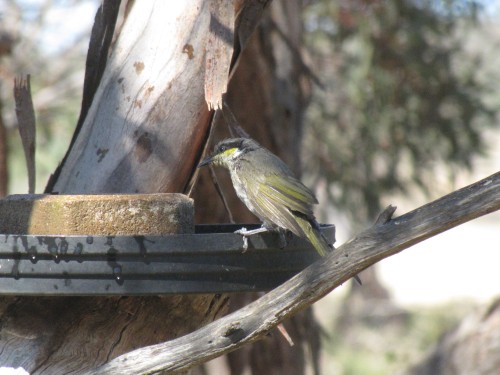Beautiful Mistletoebird
One of my favourite birds is the colourful little Mistletoebird, shown in today’s photo. I can’t say it is a resident species in our garden, but it is a frequent visitor. In our district here in Murray Bridge, South Australia, it is a widespread species occurring in small numbers. They are usually only seen singly, occasionally two.
Today my wife and I were working in our garden and a male landed briefly in a nearby Eremophila bush. It stayed only a few seconds before flying off. The male, as shown in the photo, is far more brightly coloured than the female. In the female, the red is a washed out colour and only present under the tail. She also lacks the dark blue-black colour of the male, being mainly plain brown instead.
As I didn’t have my camera with me today, the photo shown above was taken some years ago, also in our garden.
This species has a special place in our records for our home block. Over the 30 years we have lived here we have planted hundreds of trees, shrubs and bushes. The mistletoebird was the first species to make a nest in a tree we had planted. At least – it was the first one we noticed.
Grey Currawong at the bird bath
When moved to our current home and five acre block nearly 30 years ago. Over that time I have recorded over a hundred different species that have visited or flown over. About 40 of those are resident – meaning they can be seen most days – and most of those have been recorded breeding here.
The locally common Grey Currawong was a notable species absent from my lists for several decades. We would occasionally hear one calling in the distance up the hill about a kilometre away. This is an area of thick mallee scrub. They rarely ventured down into our garden.
That all changed about ten years ago. Now this species is a frequent visitor in our garden and we see or hear one or more every few days. I still wouldn’t call it a resident species, though. On a few occasions a local breeding pair have brought their recently fledged off-spring to visit too.
Even rarer is a visit to one of our bird baths, but this, too, is changing. Last week I managed a few good photos of one bird as it was drinking. Those bright yellow eyes are quite penetrating, and I am not surprised that smaller birds – like the thornbills and honeyeaters – get very nervous when the currawongs are around, sending out warning calls. That large beak would easily gobble down a nestling by the look of it.
Singing Honeyeater at the birdbath
Yesterday I wrote about New Holland Honeyeaters bathing in our bird bath (click here to view that post).
While the New Hollands are by far the most frequent and noisiest of the visitors to the bird bath, many other species also come to bathe or drink during our hot spells in summer. The New Holland Honeyeaters may come individually, but they are more prone to come in a flock of a dozen or more. The result is usually very noisy – and water sprays everywhere.
By way of contrast, the Singing Honeyeater shown in today’s photo quite often comes alone, or at most, two. They tend to be far more solitary birds in our garden. They often wait a short distance away while other species drink, then slip in quietly to drink when calmness returns.
Spotted Turtledove drops by
We have recorded over 100 species in our garden over the last 28 years. Of these, more than 40 could be regarded as resident breeding species.
One of the resident breeding birds is the introduced Spotted Turtledove. In some parts of urban Australia, this species is so common it is regarded as a pest species. In our garden, however, we only have a handful – perhaps 3 or 4 – at any one time.
They’ve been rather quiet over the last month or so; their incessant cooing can drive one to distraction if you are trying to concentrate, or have a headache. I haven’t searched the garden but they may well have been keeping quiet while they nested.
While having breakfast this morning this individual came to visit the bird bath just outside the sun room. This is a flighty, easily scared species, so it was good to get a close-up photo.
Some of the photos shown here on Trevor’s Birding can now be purchased on tee shirts, coffee mugs, stationary and a large range of other items. Go to Trevor’s Photos site here.
Beautiful Superb Fairy-wren
This morning I was sitting in our sun room doing some reading. I looked up and saw the male Superb Fairy-wren shown above and grabbed the camera before it flitted off into the vegetation. I had to take about four steps to get the camera and I was delighted that the bird stayed in position until I could focus and shoot. I only had time to manage one photo, but I’m quite happy with it. This species – like all of our wrens – are very flighty birds, never staying in one spot for more than a second or two – at best.
This individual, along with two uncoloured birds, has been resident in our garden now for over a year. This is delightful because, until a year ago, we had only recorded this species on a handful of occasions over the previous 28 years, despite them being common in our region. My next challenge is to get a shot of a female, preferably alongside the male.
The flowers belong to a Melaleuca lanceolata bush in our garden. It’s a common plant species in our area. For more about Australian native plants, have a look at my wife’s site, Mallee Native Plants.
My readers might like to also see photos of the Red-backed Fairy-wren over at Snail’s Eye View. This is one species I still have the delight to see in the wild.
Some of the photos shown here on Trevor’s Birding can now be purchased on tee shirts, coffee mugs, stationary and a large range of other items. Go to Trevor’s Photos site here.





